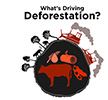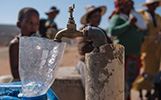| The Role of Ruminants in Reducing Agriculture's Carbon Footprint in North America
W.R. Teague, S. Apfelbaum, R. Lal, U.P. Kreuter, J. Rowntree, C.A. Davies, R. Conser, M. Rasmussen, J. Hatfield, T. Wang, F. Wang and P. Byck. , Journal of Soil and Water Conservation | March/April 2016
An alternative view of the respective role of crops and livestock in the carbon cycle, with a conclusion that regenerative management and soil conservation requires ruminant livestock to reduce GHGs from agriculture. (PDF of whole article).
Tyson Sets Water Reduction Timeline 
Bob Sims, Food Business News | April 1, 2016
Tyson Foods' touted its ongoing efforts toward expanding water conservation in the third segment of its sustainability report, which covers information on the company's environmental stewardship.
"We're setting a 12% water reduction goal by the end of 2020 for our direct operations and will talk with our supply chain, such as the independent farmers who grow animals for our company, about additional efforts they can make to conserve water," said Christine Daugherty, vice–president of sustainable food production for Tyson. "Water conservation has been an important area of focus for Tyson Foods for many years. Water is a precious, finite resource and we need to manage it responsibly from farm to finished product."
Steering Group Commences Work on Beef Sustainability Framework
Beef Central | April 4, 2016
Work to develop a sustainability framework for Australian beef production is now underway according to the steering group recently formed to tackle the task.
Why Sustainability Is Important to You
Burt Rutherford, BEEF Magazine | April 6, 2016
A study by the Center for Food Integrity shows that 60% of those surveyed strongly agree when asked, if food animals are treated decently and humanely, they would have no issue with eating meat. That, says Scott Anderson, manager of CRI Feeders in Guymon, Okla., is the good news. The bad news? "However, of that same group, only 25% believe that's true," he says.
Tops in Beef Sustainability
Barbara Duckworth, The Western Producer | April 7, 2016
Canada is a star on the world stage when it comes to sustainability on the ranch, says Dennis Laycraft, the new chair of the Global Round Table on Sustainable Beef Production.
"I am pretty proud of the progress we have made in Canada," he said at the Canadian Cattlemen's Association annual meeting last month. Research has shown that the Canadian beef industry is leaving a small carbon hoof print.
A recent study from Agriculture Canada and the University of Manitoba measured changes in greenhouse gas emissions of Canadian beef production from 1981–2011 and found a 15 percent improvement in 30 years.
Case Study – Science Proves It's Possible to Breed Green Livestock
Department of Agriculture, Fisheries and Forestry, Australia's Farming Future: Climate Change Research Program
Science proves it's possible to breed green livestock Livestock producers are used to selecting the bulls or rams they wish to buy with particular traits. Growth rate, calving or lambing ease, fertility rates, are all high on the list when looking for that perfect sire. But one day it just might be possible to select sheep or cattle that also have a smaller environmental footprint with Australian scientists proving that it is possible to breed livestock that produce less methane.
The world–class research conducted in Armidale, New South Wales, was just one part of 39 research projects coordinated by Meat & Livestock Australia through the Reducing Emissions from Livestock Research Program (RELRP). The RELRP was funded through the Australian Government's $46.2 million Climate Change Research Program (CCRP). The RELRP national program co–ordinator, Dr Julian Hill, said the RELRP, has delivered new knowledge in five main areas: genetics and animal selection, nutrition, rumen microbiology, farming systems and waste management.
Beef Sustainability and Consumer Perception – Change Happens
Bryan Weech, BEEF Magazine | April 14, 2016
If anyone thinks the beef industry is too big or too "cowboy" to be forced into change, take a look at what is happening in the pork and egg industries. Due to legislative action brought about by ballot initiative, the use of sow crates are being forced out across multiple states. Similarly, cage–free eggs are becoming a requirement at a growing number of retailers and restaurants chains across the country, with new commitments from major retailers announced seemingly daily.
Setting aside the debate about whether the use of sow crates and cages in egg production is good or bad, an interesting aspect to consider is that the ability of "popular demand" to change the practices of entire animal agriculture industries (pork & egg) has grown in proportion to the evolution of social media.
A logical question is, will activists now set their sights on the beef industry? If there are practices in the beef industry that could be questioned by consumer groups far removed from production agriculture, then the simple answer is a resounding yes!
Environmental Hourglass 
Malcolm Flanagan, Agra Europe | April 8, 2016
While visiting GRSB members in Italy last week I was introduced to the concept of the environmental hourglass; very clearly and attractively presented in this report by carni sostenibili (Summary Report PDF).
Supercharging Sustainability Metrics With Science
Mike Hower, Green Biz | April 12, 2016
Science has helped identify, quantify and measure some of the world's most pressing sustainability challenges — including climate change, water scarcity and land use — but companies traditionally have set sustainability goals in the same way they would other business goals. Often, businesses set conventional sustainability goals that stakeholders expect — that either reach for the low–hanging fruit or grasp for incremental and often random stretch goals.
But because these goals are not always intertwined with the core sustainability issues surrounding the business, firms struggle to maintain a consistent sustainability narrative. Some companies openly tout their sustainability successes, while others may be doing cool things but opt not to talk about it. Others may admit they are "sustainable" but preface it with the claim that "sustainability is a property of the entire socio–economic system and may not be achieved by the actions of a simple company."
Corporate Sustainability Is Growing Up, But Can It Evolve?
Mike Hower, Green Biz | December 14, 2015
Corporate sustainability has grown and matured in the past decade, but there is a widening gap between organizations with strong sustainability commitments and those without in terms of activities, attitudes and infrastructure, according to new research from Siemens.
And within those companies already embracing sustainability, there is a growing divide between chief sustainability officers and the C–Suite related to the role of sustainability and the impact it has on the organization. Meanwhile, the CSO community's own view of its influence and impact continues to change.
Study Finds Cattle May Reduce Greenhouse Gas Emissions from Ag
Christopher Doering, The Des Moines Register | April 8, 2016
Iowa and other Corn Belt states could reduce greenhouse gas emissions from agriculture by raising more cattle and cutting back on traditional crops such as corn and soybeans, according to a study co–authored by an Iowa State University researcher.
The study reviewed the impact cattle have on greenhouse gas emissions by comparing their environmental footprint with other forms of agriculture. While cattle produce greenhouse gas methane when they chew and digest food, row crops have a bigger impact on the environment because of the increased soil erosion that later results in the release of carbon emissions.
Beef Cattle: GLOBAL WARMING, STOP DEFORESTATION 
Union of Concerned Scientists | April, 2016
"Beef. It's what's for dinner," according to a classic marketing campaign. Whether or not this is true in your home, beef is definitely the main course on the global deforestation menu.
While many commodities are driving deforestation today, all of them take a back seat to beef cattle. It's old news that beef is the biggest deforestation driver in Latin America, but recent research suggests that it's also #1 globally.
In the countries that account for most of the deforestation caused by the four major drivers, beef is responsible for more than twice as much deforestation as the other three commodities combined.
Meat Is Madness: Why It Leads to Global Warming and Obesity
John Gibbons, The Irish Times | April 9, 2016
Globally, the production of just meat and dairy products generates 14.5 per cent of all emissions – more than the output of every car, bus, lorry, train and ship in the world, combined. The influential UK think tank Chatham House –formally the Royal Institute of International Affairs – in 2014 found low public awareness of the true costs of dietary choices. But "consumers with a higher level of awareness were more likely to indicate willingness to reduce their meat and dairy consumption for climate objectives".
One Health Colloquium: Sustainable Livestock, Disease Control, Climate Change and the Refugee Crisis
Chatham House | April 2016
In light of growing understanding and awareness of the interactions between the livestock industry and the environment, and how it relates to poverty reduction and nutritional well–being in both industrialized and developing countries, the Centre on Global Health Security is convening representatives from the World Health Organization, UN Food and Agricultural Organization, World Organisation for Animal Health, the World Bank and leading private sector groups and academic institutions to discuss the role of livestock in poverty reduction, sustainable livestock production, the value of a World One Health day for humans and animals, and innovation in vaccines and diagnostics.
Companies Get Serious About Water Use 
Richard Anderson, BBC News | April 13, 2016
Water is unlike any other commodity on Earth. For a start, we can't live without it, for very obvious reasons.
But it also underpins pretty much every activity we pursue in life – not just in our everyday lives, but in growing food, energy production and industry both large and small–scale.
Water is also unique in that it's pretty much indestructible – unlike most resources, it doesn't break down when heated up, but evaporates, constantly changing form to be transported to another place at another time. But water can no longer be seen as an infinite resource as shortages become ever more commonplace across the world. | |

